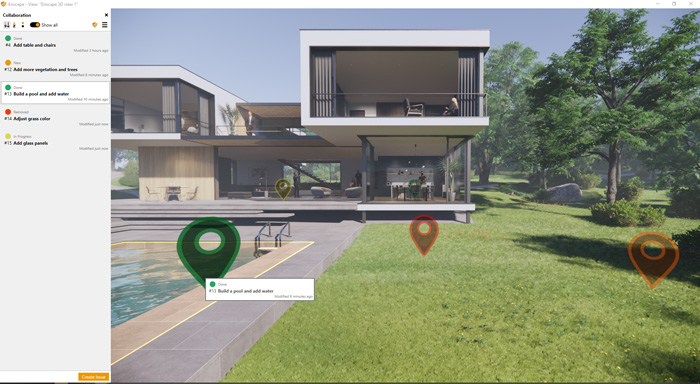Greg Corke talks virtual workstations with graphics virtualisation specialist Adam Jull, CEO of IMSCAD and IMSCAD Cloud, touching on hybrid deployments, software licensing, VR via the cloud and, of course, the ongoing impact of Covid-19
Adam Jull: Obviously, the Covid pandemic has sent everyone home to work, so there was a sudden need for remote working, so over the lockdown, many firms used their corporate VPNs to connect to their offices.
Most firms have M365 [Microsoft 365], so Internet and email was always fine, but when it came to doing production design work, the VPN in most cases was found wanting. Opening and saving design data files and just general performance is slow. After a few months, we started getting enquiries about this specific issue and how maybe they could work remotely better with local workstation performance. Then you get asked about cloud, both public and private, as well as VDI on-premise. So, the answer is yes, I believe attitudes have changed and firms want to investigate both technically and what the financial impact could be to them.
GC: As many offices have been shut during lockdown, have you seen an increase in interest towards cloud (both public and private cloud deployments)?
AJ: Yes, for a number of reasons, not always about hosted desktops either, but [also] services such as data storage, offsite back-ups and disaster recovery for business continuity. The reason being that now that everyone generally works at home, losing access to your IT environment would cause a complete shutdown of your workforce. Most firms still have an on-premise set up at their core, so using the cloud for certain key services really makes sense.
GC: Throughout the Covid-19 pandemic, what challenges have you faced with sourcing and deploying hardware – for on-premise, private, and public cloud?
AJ: For on-premise, delays from the main OEMs in shipping servers, which was completely understandable, taking double the time it usually took, but right now, things are improving and getting back to the four- to six-week timeframe for a GPU-based server.
For private cloud, there was a similar challenge, as our cloud partners purchase servers like you would on-premise to host in their data centres for customers. The work for us is the same though, deploying and supporting remotely.
For public cloud, there were a number of stories of capacity issues during the initial lockdown, as many wanted something from the cloud – usually Microsoft Azure, AWS and Google Cloud – but, to be honest, every time we have deployed anything, there has always been capacity available.
We recently did a 500-user deployment in Microsoft Azure, which when using the GPU-based NV series instances, is always a gamble to know you can acquire that many when you need them – but so far, so good.
GC: We’re hearing a lot about hybrid deployments, where firms maintain their existing investment in hardware by giving some of their newer desktop workstations a remote capability, then supplementing them with virtual workstations. What are your experiences of this?
AJ: There is no question a hybrid approach is required. You just cannot go full cloud in one go, let alone when running graphical applications and workflows where back-end resource is the key to success. As I mentioned, it is a journey to the cloud, which happens over years, not months, and much of the public cloud is just not geared up for the way AEC and manufacturing firms operate.

There is still nervousness around IP and data security, general performance as well as cost. Although billed monthly, the cloud is still expensive versus an onpremise deployment. We have customers that invest in on-premise VDI with a view that, in four years, they can take that up to a private or public cloud. User adoption is so critical and, by starting now, they have users who are tech savvy in how to work in this new environment, so when they do decide to move to the cloud, it should be seamless.
GC: What types and sizes of firms are you getting most interest from? Also, what are the smallest and largest deployments you have done?
AJ: Smallest being six users in Microsoft Azure and largest being 850 VDIs in a private cloud across US and Europe. The largest on-premise VDI is 680 users. All using graphical applications such as Autodesk, SketchUp, Adobe, Solidworks, Catia, Siemens and so on. Citrix or VMware is used for on-premise and private cloud deployments.
GC: Five years ago, there were many stories of proof of concepts (POCs) that went on forever. Now the technology has matured, and customers have more confidence in it, are deployments being rolled out faster?
AJ: Yes, I believe the technology is more accepted now. For example, we have demo servers in the US and Europe, which we allow 48-hour access to, with your own datasets to test. Once that is completed, we generally get to doing a paid production deployment.
GC: What’s the quickest deployment you did during the pandemic?
AJ: Two days in Microsoft Azure. It was not complicated, but one of the benefits of the public cloud is that it is resource on demand.
GC: What different types of endpoints do your customers use and has there been a shift over the last few years?
AJ: Firms are still willing to spend on heavily resourced laptops to help users work remotely, but the same performance issues will still remain around data access speed and reliance on your home internet. We like Igel – they are great endpoint, thin-client devices and they have a software version too.
I have even heard stories of workstations being taken home from the office. I guess people get by because they have to, but I do feel that through to the new year, firms should be really looking at this properly to find the most robust solutions for their users to work remotely, more effectively, with slick performance. Ultimately, you can work on any device you currently own; there’s no real need to buy new hardware if running VDI or from the cloud.
GC: When we spoke a few years ago, you mentioned that it was not uncommon for firms to simply virtualise key CAD/BIM applications like Solidworks / Revit/ AutoCAD, while other apps continue to run on local workstations. Has this changed now and are firms tending to run everything in the cloud/datacentre?
AJ: I would say VDI is the go-to solution and the most popular, as you get a likefor-like resourced desktop with dedicated resource for each user. Application virtualisation is still a valid option, but more customers want all applications and, importantly, their data in the environment.
GC: The hardware requirements for CAD haven’t changed that much over the years. With CPUs getting more cores and GPUs getting faster, does this mean you are able to a get much better density of users in the datacentre, or are you finding firms are now demanding more powerful workstation instances, because their workflows have changed, maybe to support complementary applications for visualisation, simulation and so on?
AJ: Yes, for sure. CPUs in servers are getting closer to local workstation speeds and they all tend to turbo up if required to handle more HPC-type workloads. Even using apps, such as Enscape or 3ds Max needs both GPU and CPU running at high speed. Normally, with Nvidia’s current crop of graphics cards, you can do it all on one card – desktops, rendering and visualisation, which is great. The density of users per GPU, as always, depends on the application mix and required resource. Sometimes it just makes sense to leave some applications on a workstation.
GC: Software licensing was originally a big challenge for virtual workstations (on-premise and in the cloud). While software developers have become more flexible, some customers have told us that there can still be barriers in place.
What are your experiences, specifically with the major players like Autodesk and Dassault Systèmes. Do firms have to get special types of licences and how readily are they made available?
AJ: Traditionally, we have mainly deployed Autodesk customers, both on-premise and in the cloud, with Citrix and VMware. In fact, we helped Autodesk certify AutoCAD for Citrix back in the day, but the recent changes they particularly have made to moving licensing to ‘Named User’ really simplifies any deployment method you may want. This takes away any issues around virtualisation or cloud, as there can’t be any audit issue if there is one user per licence. This has really solved the issue with Autodesk deployments, but there are still a few ISVs that have been slow to adapt. In my experience, there is never a technical barrier to doing anything and normally ISVs will allow it if you ask nicely.
GC: Have you had any experiences of (or requests for) streaming VR from the cloud or data centre using Nvidia CloudXR or other technologies?
AJ: Not too many, as yet, although I am sure we will. I still think there are many new technologies that will take years to be properly adopted. As always, it is all about bandwidth but, once 5G gets there, many of these things could be possible. Many firms still have not taken on virtual or cloud desktops, so running VR from the cloud could be a while.
GC: And last but not least, here’s the mandatory futures question. Where do you see the workstation landscape in five to 10 years?
AJ: One thing I always think is new technology always takes longer than you think to get adopted into businesses. The cloud is the future, no doubt, but for the next five-plus years, I don’t see firms changing from the hybrid approach.
There is a place for all of this in any enterprise and one size does not fit all. My view is more firms should be looking at ways to make remote and homeworking the best it can be and consider using the public cloud for HPC, storage and disaster recovery. One thing we must not forget is cost and still the most cost-effective way of doing a quality VDI solution is buying your own servers.
Adam Jull is chief executive officer of IMSCAD Global and IMSCAD Cloud, specialists in delivering public cloud and private cloud solutions for graphical desktops and applications, including CAD.
■ imscadglobal.com ■ imscadcloud.com
If you enjoyed this article, subscribe to our email newsletter or print / PDF magazine for FREE







